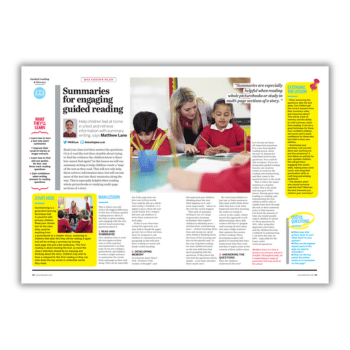Reading KS2 – how to help your pupils catch up

Are your KS2 pupils still struggling to read? Use these six suggestions to help them, says Charlotte Raby…

This year, more than 25 per cent of children in Year 6 left primary school reading at below the expected level.
The impact of this, as we all know, is that secondary school will be much harder for these children than for their peers.
The secondary curriculum is reliant on pupils reading with fluency and understanding, and when they enter KS3 not being able to read well, they can quickly lose confidence.
In our primary schools we have children in KS2 who have really missed out; those who didn’t get the teaching and attention they needed to become confident readers, especially during the pandemic. We need to do something now.
So how do we help all our children learn to read?
Class reading
Professor Teresa Cremin (president of the UK Literacy Association) often speaks about how we need to address both ‘the will and skill’ when it comes to reading.
For any child that is a wobbly reader, being read to and experiencing a rich diet of all types of literature, poetry and non-fiction is crucial to igniting that will to read.
We know that teachers who read to children every day are doing just that. And when you create a reading classroom where pupils can explore all sort of texts, comics, graphic novels, magazines and catalogues, and where reading is a shared, out-loud experience, every child can see themselves as a reader and find themselves in books.
We also know that reading time has benefits beyond the enjoyment it fosters.
When teachers read aloud and chat with children about a book, they are creating understanding, connection and memory which of course underpins reading comprehension.
Curious conversations about books that have been shared are powerful in themselves, too; they lay the foundations for meaningful comprehension in an enjoyable, inclusive fashion.
Make this part of your daily practice and you will be ensuring not only that that the children you teach experience lots of quality literature, but you will be showing them that reading is important to you – that it matters.
Alphabetic code
There are many reasons why children may need to be taught reading in KS2:
- They have missed chunks of schooling and so have gaps in their phonic knowledge
- They have not been taught with consistency and so have not secured adequate phonic knowledge to read fluently
- They need more practice and time to secure each stage of the phonic code and so have fallen behind their peers
- They are new to the country and reading/speaking English
Whatever the reason, you need a robust assessment to work out exactly what these children need and what the gaps are.
Your SSP should have an assessment that can benchmark pupils’ phonic knowledge, and you may also want to do a fluency assessment which will help you work out if reading speed and accuracy are issues, too.
But make sure the fluency assessment is at the right level and is fully decodable. Again, your SSP should have one available.
Reading plan
It’s pretty clear that children who are not reading in KS2 need urgent support and that it should be as quick and effective as possible. There is no time to waste so let’s make every minute count!
Your assessments will help you work out if you need to teach small groups of children or if they need one-to-one teaching.
Consider timetabling reading lessons before school, and providing breakfast.
Trending
It seems so unfair that children who need more help miss out on the wider curriculum, so even if before school doesn’t work, think creatively about how to timetable lessons so children don’t miss out.
We all know that a child who is missing their favourite class is going to find it harder to give these lessons their all.
To stop catch-up feeling like a chore, make one lesson a week into a celebration: whip out the hot chocolate and read to the children at the end. They are working hard, and we need to acknowledge that!
Calm atmosphere
Children who have not learned to read at the same time as their peers will have lost confidence and may show this through their behaviour.
It is vital that we make them feel safe and ready to learn in their catch-up lessons.
Pupils may feel that they cannot learn to read, that it is too difficult or not for them, so it is up to you to help them believe that they can do this by showing them that it is possible and celebrating their successes.
Older children in particular need to feel that they are not being patronised or considered ‘not intelligent’ because they have not yet learned to read.
Keep your tone warm and encouraging and the pace of the lesson brisk so that every moment is used to learn.
Try to see these lessons as a team effort with you and the children working together.
To keep the cognitive load low:
- Keep distractions to a minimum; only put out the resources that you need for the lesson
- Don’t talk too much – use the minimum talk needed to teach. Too much talk is overwhelming for some children
- Use the same teaching resources as your SSP – the same grapheme cards and grapheme charts will ensure consistency
- Use the same routines and activities; this will help pupils to focus on learning to read rather than learning a new activity
Reading is important
Phonics is only part of teaching reading. Your catch-up programme must include reading practice with fully decodable books, ideally created with older readers in mind.
Teach reading fluency, prosody and comprehension in these sessions.
Make sure that the children take these books home to practise or that they read them to another adult during the week.
Reading fluency
Children who have secured all of the phase five grapheme-phoneme correspondences (GPCs) and can read them with ease, and have a reading accuracy speed of 90+ words per minute, are ready to exit the phonics instruction part of a catch-up programme.
They will, however, need to continue reading sessions, which will ensure that they are practising their phonic knowledge in context and will provide challenge in terms of vocabulary and comprehension.
Continue to use grapheme charts in class to aid spelling and ensure that the children are given time to use their phonic knowledge to decode new words when they are reading.
Charlotte Raby is programme developer at Little Wandle. She is a champion of reading for pleasure at home and at school and never leaves the house without a book in her bag!











